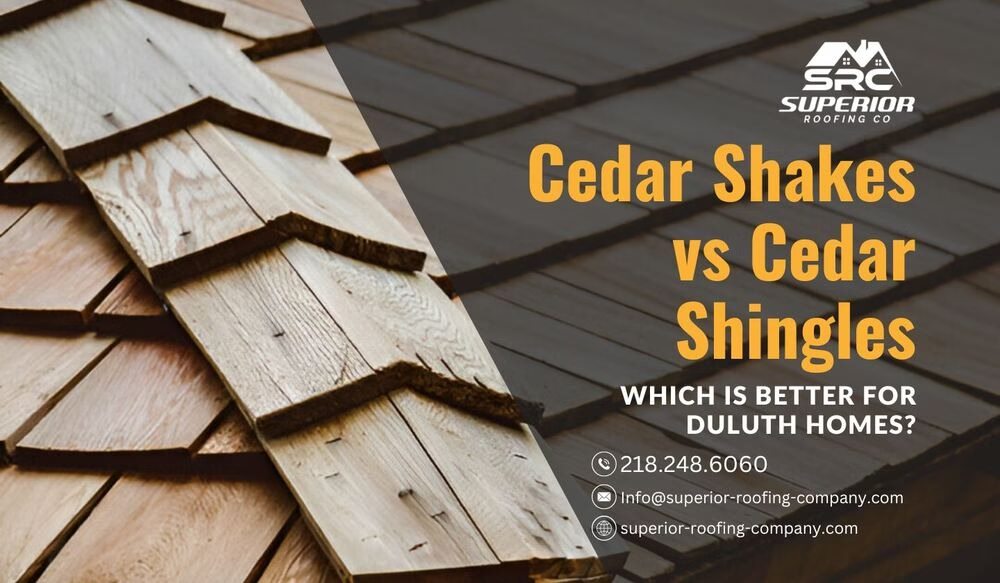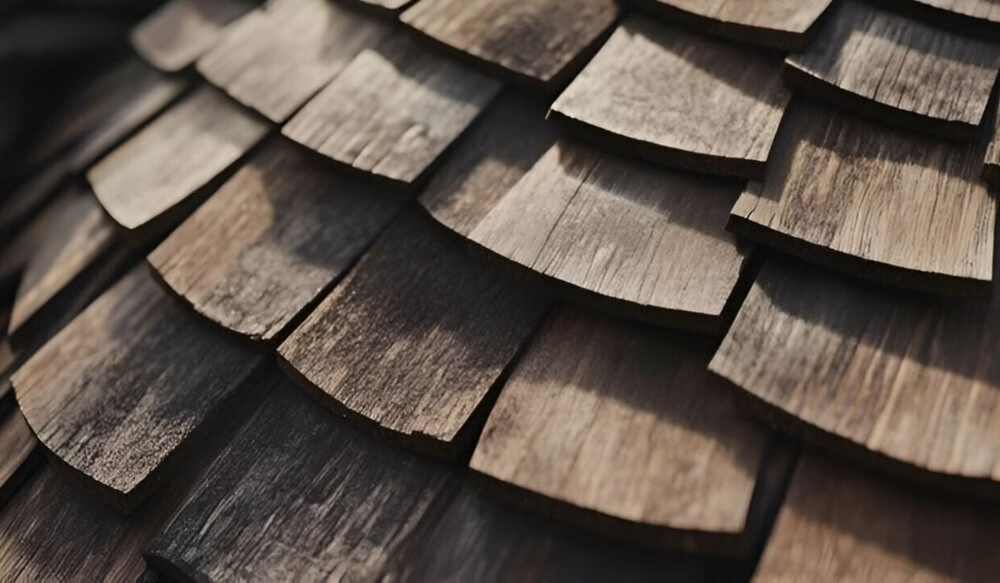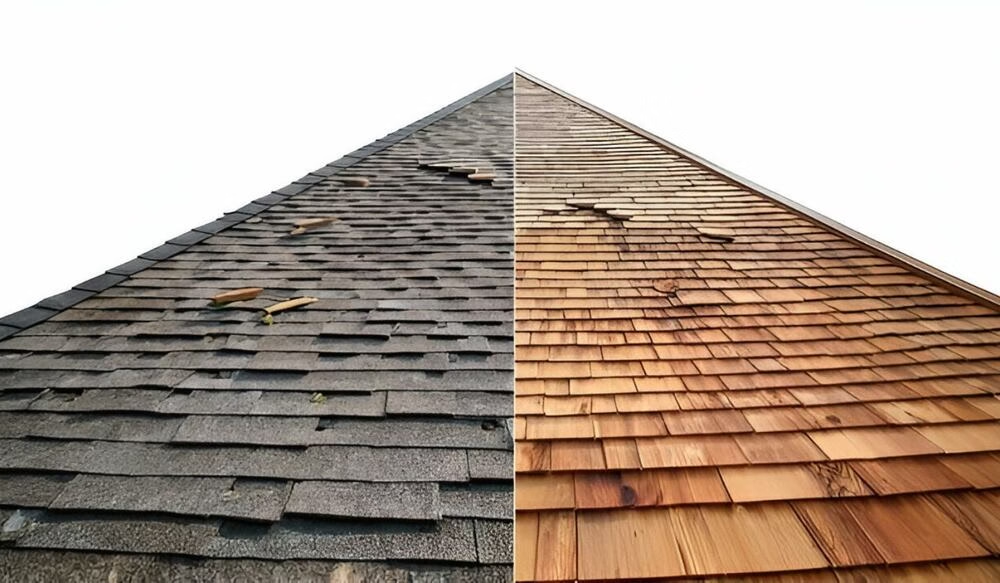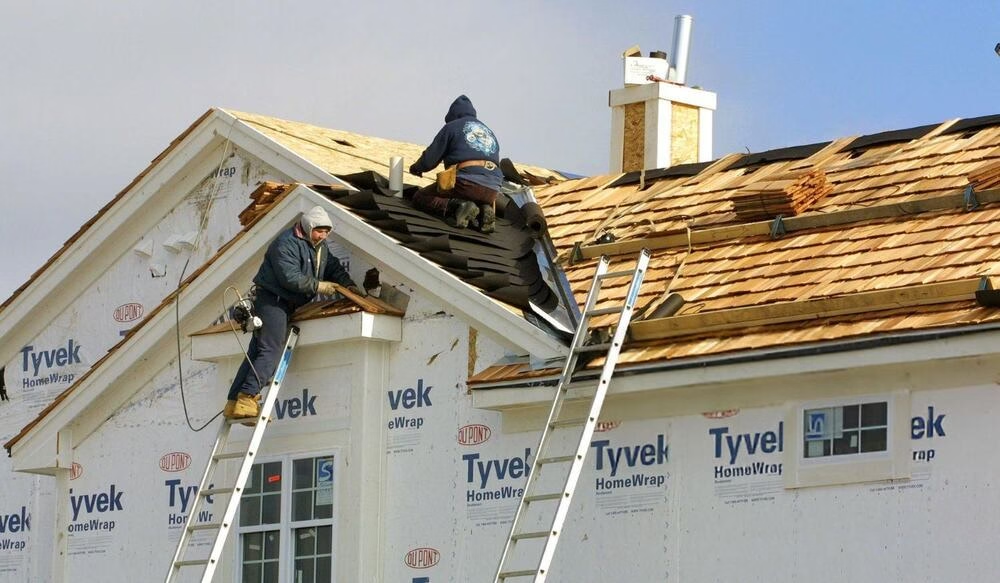When Duluth homeowners consider cedar for roofing or siding, they usually face one decisive question: Cedar Shakes vs Cedar Shingles – which is better?
The short answer is: it depends on what you value more. Rugged beauty or refined uniformity. But that sounds too easy. Let’s properly question the assumptions and lay it all out carefully before you pick sides.
What Are Cedar Shakes and Cedar Shingles, Exactly?
At a glance, both cedar shakes and shingles might seem like slight variations of the same material. But assuming they are interchangeable is a mistake – their manufacturing, performance, and appearance differ in ways that matter long after installation.
Why Are Shingles Called Shakes?
Historically, “shakes” refer to hand-split wooden pieces, while “shingles” are machine-sawn. The terminology isn’t just romantic – it speaks directly to their crafting method and, by extension, their durability.
Also read: How to Replace Roof Shingles
| Feature | Cedar Shakes | Cedar Shingles |
| Manufacturing | Hand-split from cedar logs | Machine-cut from cedar logs |
| Appearance | Rustic, textured, irregular | Smooth, uniform, refined |
| Thickness | Generally thicker | Generally thinner |
| Durability | Often more durable | Somewhat less durable |
| Aesthetic | Natural, charming, rugged | Traditional, classic, polished |
| Cost | Higher due to labor-intensive process | More affordable through precision cutting |
Cedar shakes are split by hand, often creating a rugged texture that feels organic and timeworn – fitting for Duluth’s woodsy surroundings and harsh seasons.
Cedar shingles, machine-cut and uniform, offer a crisp and clean look – ideal for historic neighborhoods, coastal homes, or anyone preferring a manicured appearance.
What Is the Major Disadvantage of Cedar Shakes?
Maintenance. If you believe cedar shakes are a “set-it-and-forget-it” material, you are setting yourself up for disappointment. Without regular sealing and inspections, shakes will age poorly, rot, or crack – particularly in Duluth’s freeze-thaw cycles.
How Long Will a Cedar Shake Roof Last?
Properly installed and maintained cedar shake roofs can last 30–40 years. But that’s assuming diligent care – annual inspections, occasional re-sealing, and timely repairs. Sloppy maintenance can slash that lifespan to 20 years or less.
Also read: How to Measure Your Roof for Shingles
Digging Deeper: Which Is Better for Duluth Homes?
Duluth’s extreme climate demands more from building materials than a simple beauty contest. Sub-zero winters, heavy snowfall, and ice dams can expose roofing weaknesses quickly.
Cedar Shakes
- Pros: Thicker, which offers better insulation and resistance against harsh elements. Their irregularity can also help shed water more naturally in heavy storms.
- Cons: Labor-intensive installation means higher upfront costs. Without regular maintenance (which Duluth’s weather demands), shakes can split, warp, or even foster moss growth.
Cedar Shingles
- Pros: Easier to install and repair. Their smoother surface makes snow and ice slide off more efficiently in some cases.
- Cons: Thinner profiles might lead to faster wear unless properly treated and maintained, especially given Duluth’s moisture levels.
Also read: Cedar Roofing Pros and Cons for Duluth, MN, Property Owners
Are Cedar Shingles Waterproof?
Not exactly. Cedar itself contains natural oils that resist moisture, but neither shakes nor shingles are fully “waterproof” out of the box. They are water-resistant, not impervious. Not only is proper overlapping during installation needed, but also water-resistant treatment needs to be done to create a water-shedding surface.
For cedar shakes and shingles, a common treatment would be something like the “Clear Water Repellent Preservative” (often abbreviated as CWRP) and the “higher-end cedar treatment”. Products like “Ready Seal”, “Thompson’s WaterSeal”, or “Wood Defender” – specifically those formulated for cedar – are frequently used. These treatments penetrate the wood fibers, helping to seal out moisture, prevent swelling, shrinking, and cracking, and inhibit mold, mildew, and UV damage.
It’s important to apply these treatments after the cedar has had time to acclimate post-installation but before it absorbs too much environmental moisture. In a place like Duluth, reapplication every 2–3 years is not only recommended but also a necessary maintenance. Otherwise, exposure to moisture without proper treatment leads to mold, mildew, and algae growth – all of which cause blackening. In Duluth’s damp environment, this is a risk you cannot afford to ignore.
The Verdict: Cedar Shakes vs Cedar Shingles for Duluth Homes
If your home demands a warm, rustic, uniquely natural look – and you are prepared for the necessary maintenance – cedar shakes are an outstanding (albeit more expensive) choice.
If you prefer a clean, classic aesthetic with easier installation and somewhat lower maintenance expectations, cedar shingles make a very practical and beautiful solution.
Neither option is inherently “better.” The better choice is the one aligned with your priorities, lifestyle, and commitment to upkeep – no shortcuts.
Trust Superior Roofing Company for Expert Cedar Roof Installations
Choosing the right material is just the beginning. Proper installation is where the real battle is won between Cedar Shakes vs Cedar Shingles. At Superior Roofing Company, we specialize in cedar shake and cedar shingle installations for Duluth homes. Our roofers understand how to prepare cedar for the unforgiving Northland climate, making sure your roof doesn’t just look great at installation but performs flawlessly for decades.
Whether you are dreaming of rustic shakes or classic shingles, we are here to guide you from material selection to expert craftsmanship. Contact us today for a consultation and free estimate on your new cedar roof installation.





